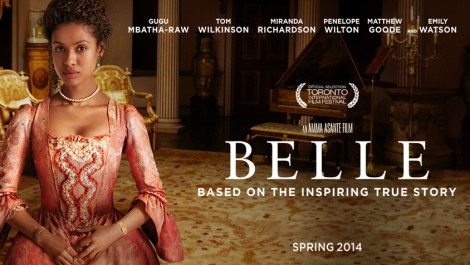I saw Amma Asante’s Belle at the Cineworld in Wandsworth this week and I must say I enjoyed it much more than expected. After Philippe Niang’s téléfilm on the story of Haitian revolutionary leader Toussaint Louverture I was worried that this would be an equally lightweight and superficial treatment of this period in colonial history. Of course there was a lot more expectation for Niang’s portrayal of Toussaint and contention over its proximity to so-called historical “truths,” but what I am more concerned with critiquing is the form of such a project and the representations (whether fictional or real) of different social actors whether in the eighteenth century pre-revolutionary society of Haiti, or in the case of Belle, a London in which men and women were coming to terms with oppositions of black/white, femininity/masculinity, master/slave and how these categories “fit” into the rigid class system of English society.
Belle tells the story of Dido Belle (played by Gugu Mbatha-Raw), a mixed race woman who is taken in and adopted by her great uncle, the Lord Chief Justice of England, the Earl of Mansfield. The story takes place against the appeal of the Zong slave ship, the eventual ruling of which, by the Lord Chief Justice himself, was thought to have contributed to the abolition of slavery in the British Empire. In November 1781, Captain Collingwood of the slave ship Zong ordered 133 Africans, who had become seriously diseased during the crossing, to be thrown overboard, in order to gain the insurance money. Ten of the men and women escaped their murderers and voluntarily threw themselves into the sea , one of whom survived and managed to climb back onboard unnoticed. The insurers refused to pay and the ship’s owners took the case to court in England in 1783 (Rupprecht 2007). The horrifying story of the Zong, more often untold than told (see the poetry collection Zong! by M. NourbeSe Philip which revisits legal archival material on the case) is central to the film, providing an important (but I believe fictional) connection to the story of Dido Belle.
There are two elements of the film I found striking. Firstly its emphasis on the idea of women as slaves and marriage as a form of slavery in eighteenth century English society. Belle’s freedom is secured by her father’s inheritance. Economic situation is therefore shown to usurp the strict social ranking assigned to her as a mixed woman of colour in white English society, enabling greater social mobility and choice. This perspective together with the relationship between the two cousins, Dido Belle and Elizabeth Murrey, suggests an ever-renewed need for research into gender and resistance to patriarchy in the colonial archive.
Secondly I was interested by the use of the portrait in the film. Asante has argued in an interview with the Guardian that the portrait (1779, which now hangs in Scone palace, Perth) inspiring the film, disrupts racial hierarchies and the stereotypical representation of people of colour in the eighteenth century:
“You see a biracial girl, a woman of colour, who’s depicted slightly higher than her white counterpart. She’s staring directly out, with a very confident eye. This painting flipped tradition and everything the 18th century told us about portraiture. What I saw was an opportunity to tell a story that would combine art history and politics.”
The portrait that is produced as a thread through the film depicts Belle with her cousin, Elizabeth Murray, in a much more equal composition than that of the original, painted the same year (1779) as over 500 Haitian gens de couleur libres (free people of colour) helped fight the British in the American Revolution.
Whether in reality Lord Mansfield finally ruled as he did out of compassion and a concern for human rights is questionable; the Zong case was considered an insurance matter not a murder trial. What is important however is that despite the occasional period drama cliché (where under normal circumstances I would be wincing), I left the cinema feeling thoroughly enthused by the film and was immediately recommending it to friends and family after viewing. Unlike Steve McQueen’s excellent 12 Years a Slave, which makes for uneasy viewing on DVD in the comfort of your own home, the latest of the new films on slavery currently “trending” can (and should) be shown again and again and may even provoke renewed interest in the silences and historical gaps surrounding the tragic affair of the Zong.


